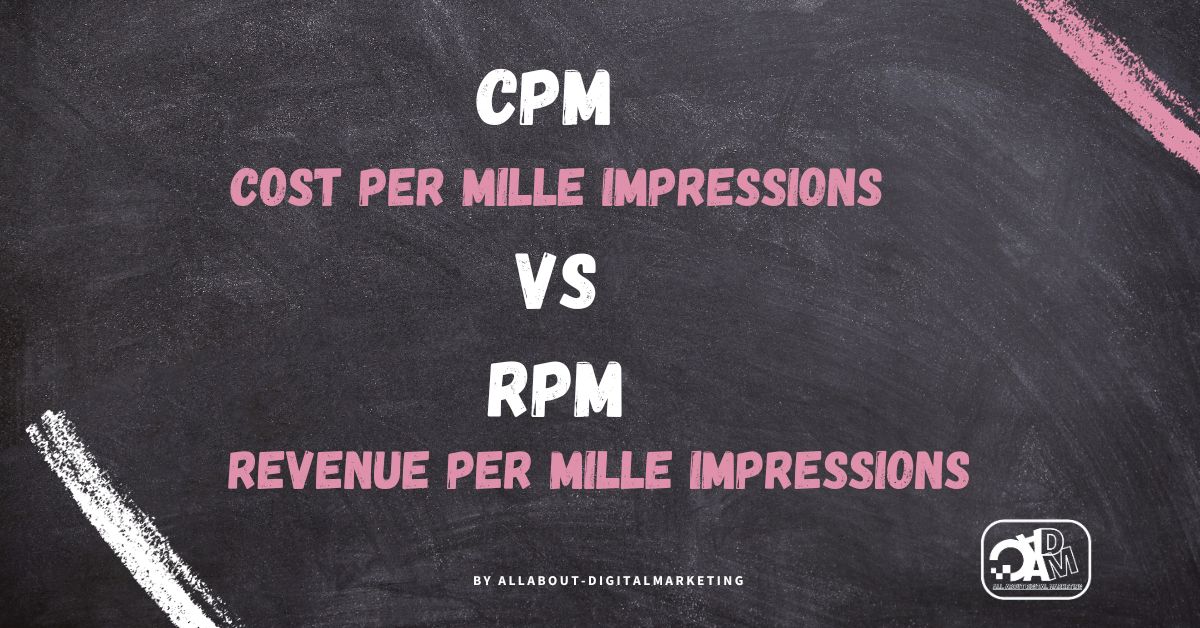As a publisher in the digital landscape, understanding the metrics that drive your revenue is paramount. Two key performance indicators, CPM (Cost Per Mille) and RPM (Revenue Per Mille), play a pivotal role in determining your financial success. In this comprehensive guide, we will delve into the nuances of CPM vs. RPM, offering insights and best practices that will empower you to optimize your monetization strategies.
Introduction
Before we explore the differences and applications of CPM vs RPM, let’s get a clear understanding of what each of these terms means:
CPM (Cost Per Mille)
CPM, short for “Cost Per Mille” (Mille being Latin for thousand), represents the cost an advertiser is willing to pay for a thousand impressions of their ad. It is a common metric used to evaluate the effectiveness of advertising campaigns. As a publisher, CPM directly impacts your earnings, as it dictates the revenue generated from every thousand ad impressions.
RPM (Revenue Per Mille)
On the other hand, RPM, which stands for “Revenue Per Mille,” measures the total earnings you receive for every thousand ad impressions on your website. RPM provides a comprehensive view of your site’s overall monetization performance.
Now that we have a clear understanding of these two crucial metrics let’s dive into the specifics of CPM and RPM.
CPM: A Closer Look
CPM is a metric that primarily concerns advertisers. It’s the price an advertiser pays to display their ad on your website for every thousand impressions. High CPM rates indicate that advertisers are willing to pay more to showcase their ads on your site. Here are some key points to consider regarding CPM:
- Ad Quality Matters: High-quality content and a well-defined audience attract advertisers willing to pay a premium CPM.
- Geographical Differences: CPM can vary significantly by region. Targeting audiences in high-paying regions can increase your overall CPM.
- Ad Placement: The placement of ads on your website can influence CPM. Above-the-fold placements often yield higher CPM rates.
- Auction Dynamics: CPM is often determined through real-time bidding in ad exchanges. Understanding the auction dynamics can help you optimize CPM.
RPM: Maximizing Publisher Revenue
RPM, on the other hand, is all about the revenue you, as a publisher, earn from those impressions. It gives you a broader perspective on your overall monetization performance. Here’s what you should know about RPM:
Comprehensive Revenue: RPM encapsulates all your revenue sources, including CPM, CPC (Cost Per Click), and CPA (Cost Per Acquisition). It’s a holistic metric.
- Content Quality: Just like with CPM, the quality of your content and audience engagement plays a significant role in boosting RPM.
- Optimizing Ad Layout: Ad placements and user experience design can significantly impact RPM. Striking the right balance between user experience and ad placement is key.
- Diversifying Revenue Streams: Besides display ads, consider other revenue streams like affiliate marketing and sponsored content to enhance your RPM.
CPM vs RPM: Which One Should You Focus On?
Now, the million-dollar question – should you prioritize CPM or RPM? The answer lies in your business strategy and goals. Here are some factors to consider:
- Maximizing CPM: If you have a niche audience or produce content that attracts high-paying advertisers, focusing on CPM optimization might be your best strategy.
- Balancing CPM and RPM: Striking a balance between CPM and RPM is often the ideal approach. Ensure that you don’t compromise user experience while boosting CPM.
- Content and Audience Analysis: Regularly analyze your content’s performance and audience engagement to identify the right balance for your site.
- A/B Testing: Experiment with ad placements, formats, and types to find the sweet spot that maximizes both CPM and RPM.
Example to understand these better
let’s use an example to illustrate the concepts of CPM and RPM for a publisher with six ad units on a single page.
Scenario: Imagine a publisher who runs a popular technology news website. This publisher has six ad units on each of their article pages. These ad units include banner ads, sidebar ads, and in-article ads.
Ad Unit 1 – Banner Ad
- Impressions: This ad unit is located at the top of the article page and gets approximately 100,000 views per month. This means it generates 100,000 impressions each month.
- CPM: Advertisers in the technology niche are willing to pay a premium for the top banner spot. The CPM for this ad unit is $5.
- Monthly Earnings: To calculate the monthly earnings for this ad unit, we use the formula: (Impressions / 1,000) x CPM. In this case, it’s (100,000 / 1,000) x $5 = $500.
Ad Unit 2 – Sidebar Ad
- Impressions: This ad unit is located in the sidebar and gets around 150,000 views per month.
- CPM: The CPM for this sidebar ad is lower, at $2, as it’s less prominent than the top banner.
- Monthly Earnings: Using the same formula, the monthly earnings for this ad unit are (150,000 / 1,000) x $2 = $300.
Ad Units 3-6 – In-Article Ads
- Impressions: These four ad units are placed within the articles and together receive a total of 300,000 views each month.
- CPM: Since these ads are more targeted and relevant to the content, they command a higher CPM of $6.
- Monthly Earnings: The combined monthly earnings for these four in-article ad units are (300,000 / 1,000) x $6 = $1,800.
Now, let’s calculate the overall RPM for this publisher:
- Total Monthly Earnings: To find the total monthly earnings, sum the earnings from all ad units: $500 (Banner) + $300 (Sidebar) + $1,800 (In-Article) = $2,600.
- Total Impressions: Sum the total impressions from all ad units: 100,000 (Banner) + 150,000 (Sidebar) + 300,000 (In-Article) = 550,000 impressions.
- RPM (Revenue Per Mille): To calculate RPM, divide the total earnings by total impressions and then multiply by 1,000. In this case, ($2,600 / 550,000) x 1,000 = $4.73.
So, the publisher’s RPM for their website in this scenario is $4.73. This means that for every 1,000 impressions on their site, they earn approximately $4.73 in revenue.
In summary, this example shows how a publisher’s revenue is influenced by the CPM of each ad unit on their page. Ad units with higher CPMs contribute more to their total earnings. Balancing CPM and RPM across various ad units is crucial to maximize overall revenue without compromising the user experience.
Best Practices for CPM and RPM Optimization
Here are some best practices to help you maximize your CPM and RPM effectively:
Audience Segmentation
Divide your audience into segments to attract advertisers willing to pay more for highly targeted ads. This can lead to an increase in CPM.
Quality Content
Always prioritize high-quality, engaging content that keeps users on your site longer. This can improve RPM as well as CPM by attracting premium advertisers.
Ad Layout and User Experience
Optimize ad placement for a positive user experience. Test different ad formats and positions to strike the right balance.
Geographical Targeting
Consider targeting audiences in regions with higher CPM potential to increase your overall revenue.
Diversify Revenue Streams
Explore additional revenue sources like affiliate marketing, subscriptions, or selling digital products.
Conclusion
In the world of digital publishing, understanding the difference between CPM and RPM is vital. While CPM represents what advertisers are willing to pay for ad impressions, RPM showcases the actual revenue generated from those impressions. As a publisher, striking the right balance between these metrics is essential for maximizing your earnings. The key is to focus on quality content, audience engagement, and strategic ad placement while continuously optimizing your strategy to ensure long-term success.
Remember, the path to success often involves experimenting, learning from the data, and adapting to changing market dynamics. By following these best practices and understanding the dynamics of CPM and RPM, you can make informed decisions that drive revenue growth for your publishing business.
Frequently Asked Questions (FAQs)
What is the ideal CPM rate for a publisher?
A1: There’s no one-size-fits-all ideal CPM rate, as it varies based on factors like your audience, niche, and region. However, striving for CPM rates above $2 is generally a good starting point.
How can I improve my RPM?
To enhance your RPM, focus on creating high-quality, engaging content, optimizing ad placements, and diversifying your revenue sources. Regularly analyze your data and adapt your strategy accordingly.
CPM or RPM which one to focus, or should I balance both?
It’s often advisable to strike a balance between CPM and RPM. Focusing on just one metric may lead to suboptimal results. Balancing both can help maximize your overall revenue.
Are there tools to help me track and optimize CPM and RPM?
A4: Yes, various ad management and analytics platforms offer tools to track and optimize CPM and RPM. Google Ad Manager, AdSense, and Ad Exchange are popular choices for publishers.
How can I test ad placements without compromising the user experience?
A/B testing is an effective way to experiment with ad placements while maintaining a positive user experience. Make incremental changes, gather data, and refine your strategy based on the results.
Remember that your strategy should evolve alongside the ever-changing digital landscape. Stay informed, adapt, and always prioritize delivering value to your audience. By doing so, you’ll be well on your way to mastering the art of CPM and RPM optimization.
References
HubSpot – How to Calculate RPM for Your Website

